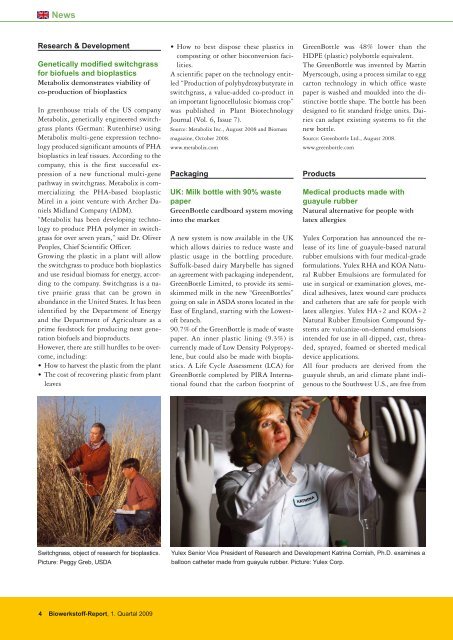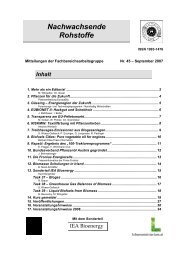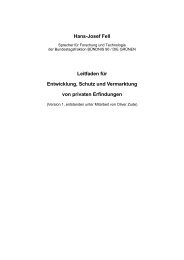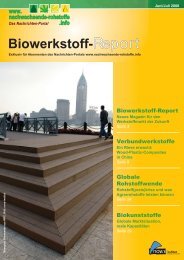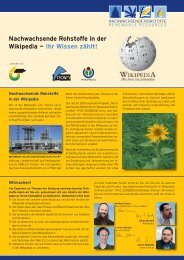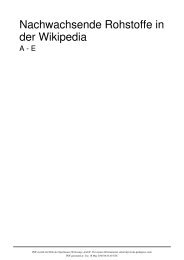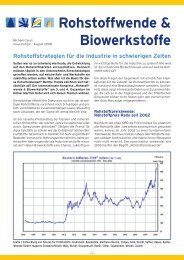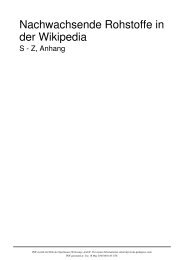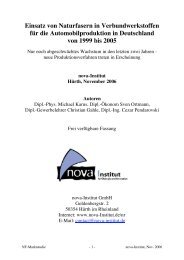Biowerkstoff-Report, Ausgabe 5, Februar 2009 - nova-Institut GmbH
Biowerkstoff-Report, Ausgabe 5, Februar 2009 - nova-Institut GmbH
Biowerkstoff-Report, Ausgabe 5, Februar 2009 - nova-Institut GmbH
Erfolgreiche ePaper selbst erstellen
Machen Sie aus Ihren PDF Publikationen ein blätterbares Flipbook mit unserer einzigartigen Google optimierten e-Paper Software.
News<br />
Research & Development<br />
Genetically modified switchgrass<br />
for biofuels and bioplastics<br />
Metabolix demonstrates viability of<br />
co-production of bioplastics<br />
In greenhouse trials of the US company<br />
Metabolix, genetically engineered switchgrass<br />
plants (German: Rutenhirse) using<br />
Metabolix multi-gene expression technology<br />
produced significant amounts of PHA<br />
bioplastics in leaf tissues. According to the<br />
company, this is the first successful expression<br />
of a new functional multi-gene<br />
pathway in switchgrass. Metabolix is commercializing<br />
the PHA-based bioplastic<br />
Mirel in a joint venture with Archer Daniels<br />
Midland Company (ADM).<br />
“Metabolix has been developing technology<br />
to produce PHA polymer in switchgrass<br />
for over seven years,” said Dr. Oliver<br />
Peoples, Chief Scientific Officer.<br />
Growing the plastic in a plant will allow<br />
the switchgrass to produce both bioplastics<br />
and use residual biomass for energy, according<br />
to the company. Switchgrass is a native<br />
prairie grass that can be grown in<br />
abundance in the United States. It has been<br />
identified by the Department of Energy<br />
and the Department of Agriculture as a<br />
prime feedstock for producing next generation<br />
biofuels and bioproducts.<br />
However, there are still hurdles to be overcome,<br />
including:<br />
How to harvest the plastic from the plant<br />
The cost of recovering plastic from plant<br />
leaves<br />
Switchgrass, object of research for bioplastics.<br />
Picture: Peggy Greb, USDA<br />
4 <strong>Biowerkstoff</strong>-<strong>Report</strong>, 1. Quartal <strong>2009</strong><br />
How to best dispose these plastics in<br />
composting or other bioconversion facilities.<br />
A scientific paper on the technology entitled<br />
“Production of polyhydroxybutyrate in<br />
switchgrass, a value-added co-product in<br />
an important lignocellulosic biomass crop”<br />
was published in Plant Biotechnology<br />
Journal (Vol. 6, Issue 7).<br />
Source: Metabolix Inc., August 2008 and Biomass<br />
magazine, October 2008.<br />
www.metabolix.com<br />
Packaging<br />
UK: Milk bottle with 90% waste<br />
paper<br />
GreenBottle cardboard system moving<br />
into the market<br />
A new system is now available in the UK<br />
which allows dairies to reduce waste and<br />
plastic usage in the bottling procedure.<br />
Suffolk-based dairy Marybelle has signed<br />
an agreement with packaging independent,<br />
GreenBottle Limited, to provide its semiskimmed<br />
milk in the new “GreenBottles”<br />
going on sale in ASDA stores located in the<br />
East of England, starting with the Lowestoft<br />
branch.<br />
90.7% of the GreenBottle is made of waste<br />
paper. An inner plastic lining (9.3%) is<br />
currently made of Low Density Polypropylene,<br />
but could also be made with bioplastics.<br />
A Life Cycle Assessment (LCA) for<br />
GreenBottle completed by PIRA International<br />
found that the carbon footprint of<br />
GreenBottle was 48% lower than the<br />
HDPE (plastic) polybottle equivalent.<br />
The GreenBottle was invented by Martin<br />
Myerscough, using a process similar to egg<br />
carton technology in which office waste<br />
paper is washed and moulded into the distinctive<br />
bottle shape. The bottle has been<br />
designed to fit standard fridge units. Dairies<br />
can adapt existing systems to fit the<br />
new bottle.<br />
Source: Greenbottle Ltd., August 2008.<br />
www.greenbottle.com<br />
Products<br />
Medical products made with<br />
guayule rubber<br />
Natural alternative for people with<br />
latex allergies<br />
Yulex Corporation has announced the release<br />
of its line of guayule-based natural<br />
rubber emulsions with four medical-grade<br />
formulations. Yulex RHA and KOA Natural<br />
Rubber Emulsions are formulated for<br />
use in surgical or examination gloves, medical<br />
adhesives, latex wound care products<br />
and catheters that are safe for people with<br />
latex allergies. Yulex HA+2 and KOA+2<br />
Natural Rubber Emul sion Compound Systems<br />
are vulcanize-on-demand emulsions<br />
intended for use in all dipped, cast, threaded,<br />
sprayed, foamed or sheeted medical<br />
device applications.<br />
All four products are derived from the<br />
guayule shrub, an arid climate plant indigenous<br />
to the Southwest U.S., are free from<br />
Yulex Senior Vice President of Research and Development Katrina Cornish, Ph.D. examines a<br />
balloon catheter made from guayule rubber. Picture: Yulex Corp.


